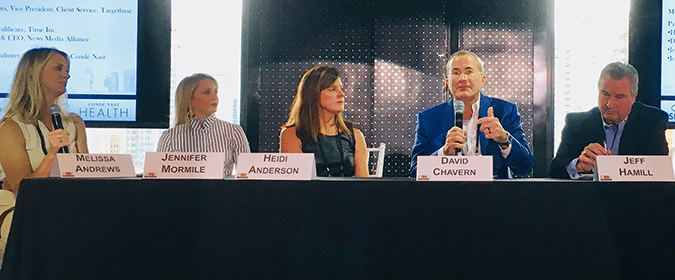
Last week, the DTC Forum on Television & Print in New York City discussed how the pharmaceutical industry can benefit from advertisements on TV and in print publications. Among the talks were several on how print ads can help the pharmaceutical industry reach a wider and more engaged audience. We’ve recapped some of the key talking points on the benefits of print and how marketers can leverage print in their advertising strategy.
Print Isn’t Dead!
While the speakers primarily covered magazines in their discussions of pharmaceutical ads, the fact that print remains a heavy hitter is good news. According to Dave Emery, VP/General Manager, Healthcare Research of Kantar Media, heavy magazine readers (those who spend five hours or more per week reading publications) are 73 percent more likely to recall health care ads they’ve seen in print, and those who’ve seen an ad are 45 percent more likely to act as a result of it.
Meanwhile, people with chronic conditions are 9 percent more likely to be heavy readers, and 172 percent more likely to refer to a print publication for more information on a drug or condition. They are also 129 percent more likely to discuss an ad they’ve seen with their doctors.
The takeaway: Print ads are memorable and actionable.
Print Ads Heavily Impact Sales
To benefit from print, advertisers need to run ads in multiple publications over an extended period of time. However, with smaller advertising budgets and more advertising options, it’s not always the default for advertisers.
But print can drive that action more than you might assume. According to Cleveland, during one case study, which featured a pharmaceutical company purchasing ads across five Meredith publications for a period of six months, they saw a 22 percent increase in conversions from non-prescribers to prescribers. The company also got an ROI of $8.93 for every advertising dollar spent on those ads.
Takeaway: You have to spend money to make money, and you’re more likely to make money in print.
Don’t Focus On Subscribers Alone
The great thing about advertising in print is that you aren’t getting just the subscribers, but also their friends, family and colleagues. That’s because print benefits from “passalong,” or the people who aren’t subscribers (or newsstand purchasers) who read each copy of a magazine or newspaper. For many publications, that passalong number can double or triple the number of people you’re reaching — or more!
Part of the passalong benefits come from point-of-care readers, who are encountering ads while reading a magazine or newspaper in the doctor’s office waiting room, as well as caregivers, , who may share the ad with family members.
Takeaway: When you advertise in print, you’re reaching more than just subscribers.
Print Is Ideal for Complex Thinking
Another reason advertising pharmaceutical products in print is so effective is that people are willing to take on new ideas. As News Media Alliance President & CEO David Chavern pointed out, print readers are already thinking seriously and critically when reading the news, so if you present an ad that requires a little more consideration, they’re in the right mindset to receive it and engage with it.

Whereas digital and television are faster mediums, print is slower, and readers are willing to take more time with content, Chavern said. That means that a pharmaceutical ad, which is text-heavy because of the “fair balance” rule (which requires the companies to list all the potential negative side effects of a drug if they’re mentioning any positive claims), is more likely to be read in print.
Print allows advertisers to create synergy across platforms. For example, a television ad can drive a reader to a print ad, where people have more time to engage with the content. And that print ad can drive them to a website, where they can take more action. As Chavern pointed out, news media companies are already operating with that synergy in mind when they create news content, so advertising across news platforms makes it easy to develop brand recognition among consumers.
Takeaway: If you want people to engage at a more-detailed level with your ad, print is the way to go.
People Hate Ads — Except in Print
Jeff Hamill, from Hearst, said that “print doesn’t have a consumer problem, it has an ad problem.” When digital came along, advertisers flocked to the new medium, but people have continued to read print even while digital has grown exponentially. And that’s because print is essentially comfort food for the brain. It’s something familiar and easy to engage with, and everyone reads print. Even digital giants like Facebook and Google advertise in print, and digital leaders continuously look to print for ideas on how to grow and innovate.
While people use ad-blockers and fast-forward through commercials in digital and TV, respectively, to avoid ads in those mediums, print ads are always there — and no one minds. Print ads are less “annoying” to consumers, and that makes them more likely to engage with the ad content when they see it. It also helps create a positive perception of the ad, rather than a negative one, as people sometimes feel when seeing online ads.
Takeaway: People are more willing to engage with an ad in print because they’re used to doing so and it’s not as intrusive.
For more from the DTC Forum on Television & Print, you can check out the Alliance’s #DTCFTP17 tweets shared during the conference:
Tweets about #DTCFTP17 from:editrixjen
